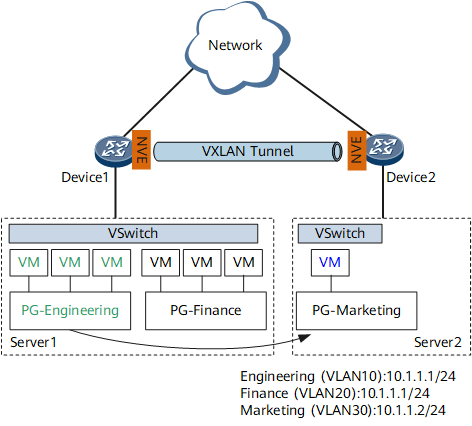Application in VM Migration Scenarios
Service Description
Enterprises configure server virtualization on DCNs to consolidate IT resources, improve resource use efficiency, and reduce network costs. With the wide deployment of server virtualization, an increasing number of VMs are running on physical servers, and many applications are running in virtual environments, which bring great challenges to virtual networks.
Network Description
On the network shown in Figure 1, an enterprise has two servers in the DC: engineering and finance departments on Server1 and the marketing department on Server2.
The computing space on Server1 is insufficient, but Server2 is not fully used. The network administrator wants to migrate the engineering department to Server2 without affecting services.
This scenario applies to IPv4 over IPv4, IPv6 over IPv4, IPv4 over IPv6, and IPv6 over IPv6 networks. Figure 1 shows an IPv4 over IPv4 network.
Feature Deployment
To ensure uninterrupted services during the migration of the engineering department, the IP and MAC addresses of the engineering department must remain unchanged. This requires that the two servers belong to the same Layer 2 network. If conventional migration methods are used, the administrator may have to purchase additional physical devices to distribute traffic and reconfigure VLANs. These methods may also result in network loops and additional system and management costs.
VXLAN can be used to migrate the engineering department to Server2. VXLAN is a network virtualization technology that uses MAC-in-UDP encapsulation. This technology can establish a large Layer 2 network connecting all terminals with reachable IP routes, as long as the physical network supports IP forwarding.
The engineering department is migrated to Server2 through the VXLAN tunnel. Online users are unaware of the migration. After the engineering department is migrated from Server1 to Server2, terminals send gratuitous ARP or RARP packets to update all gateways' MAC addresses and ARP entries of the original VMs to those of the VMs to which the R&D department is migrated.
